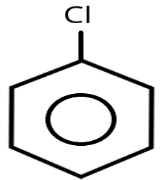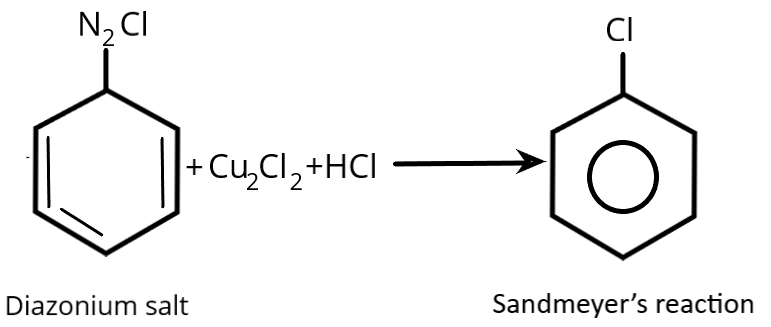
\[Diazonium~salts + C{u_2}C{l_2} + HCl \to \] , the reaction is known as
, the reaction is known as
A. Chlorination
B. Sandmeyer’s reaction
C. Perkin reaction
D. Carbyl amine reaction
Answer
224.7k+ views
Hint: A group of organic compounds known as diazonium salts have a functional group \[[RN_2]X\] that can have any kind of organic group \[R\], like an aryl or an alkyl, and an inorganic or organic anion, like a halide. It is used in many multiple reactions to form new organic compounds.
Complete step-by-step answer:Diazotization is a chemical reaction in which amine gets converted into diazonium salt with the help of sodium nitrite and HCl at low temperatures of 0-5 degree celsius. The creation of the azo compound is caused by the reaction of benzene-diazonium chloride with another chemical containing a benzene ring known as a coupling specialist, such as phenol or aromatic amine.
By heating aryl azide and cuprous halide, Sandmeyer's reaction produces halobenzene.
Halobenzene is created using Sandmeyer's reaction. For the creation of alkyl fluorides, it cannot be employed. It is an illustration of an aromatic radical-nucleophilic substitution. The Sandmeyer’s reaction for the formation of chlorobenzene is shown below.

Therefore, the given reaction represents Sandmeyer's reaction.
Option ‘B’ is correct
Note:It should be noted that the finding of biaryl byproducts lends support to the radical mechanism of the Sandmeyer reaction. A one-electron transfer mechanism that is catalysed by copper\[(I)\] causes the aromatic diazo group to be replaced with a halogen or pseudohalogen, forming an aryl radical with the loss of nitrogen gas. The substitutes may be produced and the copper\[(I)\] catalyst restored by direct transfer of \[Cl,Br\] or \[OH\] from a copper\[(II)\] species to the aryl radical.
Complete step-by-step answer:Diazotization is a chemical reaction in which amine gets converted into diazonium salt with the help of sodium nitrite and HCl at low temperatures of 0-5 degree celsius. The creation of the azo compound is caused by the reaction of benzene-diazonium chloride with another chemical containing a benzene ring known as a coupling specialist, such as phenol or aromatic amine.
By heating aryl azide and cuprous halide, Sandmeyer's reaction produces halobenzene.
Halobenzene is created using Sandmeyer's reaction. For the creation of alkyl fluorides, it cannot be employed. It is an illustration of an aromatic radical-nucleophilic substitution. The Sandmeyer’s reaction for the formation of chlorobenzene is shown below.

Therefore, the given reaction represents Sandmeyer's reaction.
Option ‘B’ is correct
Note:It should be noted that the finding of biaryl byproducts lends support to the radical mechanism of the Sandmeyer reaction. A one-electron transfer mechanism that is catalysed by copper\[(I)\] causes the aromatic diazo group to be replaced with a halogen or pseudohalogen, forming an aryl radical with the loss of nitrogen gas. The substitutes may be produced and the copper\[(I)\] catalyst restored by direct transfer of \[Cl,Br\] or \[OH\] from a copper\[(II)\] species to the aryl radical.
Recently Updated Pages
JEE Main 2025-26 Mock Test: Organic Compounds Containing Nitrogen

JEE Main 2025-26 Organic Compounds Containing Nitrogen Mock Test

JEE Main Chemical Kinetics Mock Test 2025-26: Free Practice Online

JEE Main 2025-26 Organic Compounds Containing Oxygen Mock Test

JEE Main 2025-26 Organic Compounds Containing Halogens Mock Test

Sodium acetate on heating with soda lime produce A class 12 chemistry JEE_Main

Trending doubts
JEE Main 2026: City Intimation Slip and Exam Dates Released, Application Form Closed, Syllabus & Eligibility

JEE Main 2026 Application Login: Direct Link, Registration, Form Fill, and Steps

Understanding the Angle of Deviation in a Prism

How to Convert a Galvanometer into an Ammeter or Voltmeter

Hybridisation in Chemistry – Concept, Types & Applications

Ideal and Non-Ideal Solutions Explained for Class 12 Chemistry

Other Pages
NCERT Solutions For Class 12 Chemistry Chapter 1 Solutions - 2025-26

JEE Advanced Marks vs Ranks 2025: Understanding Category-wise Qualifying Marks and Previous Year Cut-offs

Solutions Class 12 Chemistry Chapter 1 CBSE Notes - 2025-26

NCERT Solutions ForClass 12 Chemistry Chapter Chapter 4 The D and F Block Elements

Biomolecules Class 12 Chemistry Chapter 10 CBSE Notes - 2025-26

NCERT Solutions For Class 12 Chemistry Chapter 10 Biomolecules - 2025-26




